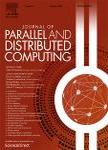版权所有:内蒙古大学图书馆 技术提供:维普资讯• 智图
内蒙古自治区呼和浩特市赛罕区大学西街235号 邮编: 010021

作者机构:Univ Fed Rio de Janeiro COPPE Programa Engn Sistemas & Computacao BR-21941972 Rio De Janeiro Brazil
出 版 物:《JOURNAL OF PARALLEL AND DISTRIBUTED COMPUTING》 (并行与分布式计算杂志)
年 卷 期:2009年第69卷第3期
页 面:261-265页
核心收录:
学科分类:08[工学] 0812[工学-计算机科学与技术(可授工学、理学学位)]
基 金:CNPq CAPES FAPERJ BBP
主 题:Distributed computing Sensor networks Clock synchronization Gradient property in clock synchronization
摘 要:We introduce a distributed algorithm for clock synchronization in sensor networks. Our algorithm assumes that nodes in the network only know their immediate neighborhoods and an upper bound on the network s diameter. Clock-synchronization messages are only sent as part of the communication-assumed to be reasonably frequent-that already takes place among nodes. The algorithm has the gradient property of [R. Fan, N. Lynch, Gradient clock synchronization, Distributed Computing 18 (2006) 255-266], achieving an O(1) worst-case skew between the logical clocks of neighbors. The algorithm s actions are such that no constant lower bound exists on the rate at which logical clocks progress in time, and for this reason the lower bound of [R. Fan, N. Lynch, Gradient clock synchronization, Distributed Computing 18 (2006) 255-266;L Meier, L Thiele, Brief announcement: Gradient clock synchronization in sensor networks, in: Proceedings of the Twenty-Fourth Annual ACM Symposium on Principles of Distributed Computing, 2005, p. 238] that forbids a constant clock skew between neighbors does not apply. (C) 2008 Elsevier Inc. All rights reserved.